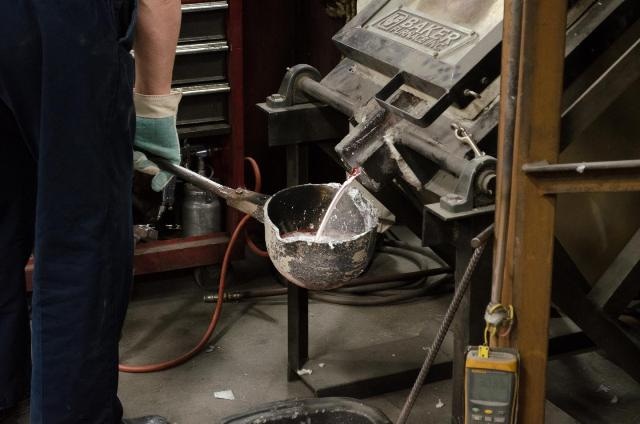Jun 6 2016
A team of researchers from the Department of Energy at Oak Ridge National Laboratory has partnered with Wisconsin-based Eck Industries and Lawrence Livermore National Laboratory (LLNL) to create aluminum alloys that have easier workability and better tolerance to heat than currently available products.
 These are alloyed metals being poured from a furnace into a ladle, to be used to fill molds. (Photo Credit: Zachary Sims, ORNL)
These are alloyed metals being poured from a furnace into a ladle, to be used to fill molds. (Photo Credit: Zachary Sims, ORNL)
Another crucial aspect is that the alloys, which contain cerium, possesses the potential to increase production of rare earth elements in the US.
Zach Sims, Michael McGuire and Orlando Rios from ORNL, along with colleagues from Eck, LLNL and Ames Laboratory in Iowa, discussed the economic and technical possibilities for aluminum–cerium alloys in an article in JOM, a publication of the Minerals, Metals & Materials Society.
The team is functioning as part of the Critical Materials Institute, an Energy Innovation Hub developed by the U.S. Department of Energy (DOE) and managed out of DOE's Advanced Manufacturing Office. The institute is based at Ames, and aims to enhance the availability of rare earth metals and other materials essential for energy security in the U.S.
Rare earths are elements vital to alternative energy, electronics, and other advanced technologies. Latest hybrid autos and windmills, for instance, depend on powerful permanent magnets composed of rare earth elements dysprosium and neodymium. However, there is still no production happening in North America so far.
One issue is that cerium makes up to half of the rare earth content of several rare earth ores, including ones found in the US. It has been hard for rare earth producers to locate a market to sell all of the cerium that is mined. The most common rare earth ore in the US is composed of 500 times more cerium than dysprosium, and three times more cerium than neodymium.
Aluminum–cerium alloys have the potential to improve domestic rare earth mining by enhancing the demand and, ultimately, the value of cerium.
We have these rare earths that we need for energy technologies, but when you go to extract rare earths, the majority is cerium and lanthanum, which have limited large-volume uses.
Orlando Rios
For instance, if the new alloys are adapted for use in internal combustion engines, they could swiftly convert cerium from a problematic byproduct of rare earth mining to an important product in itself.
“The aluminum industry is huge,” Rios explained. “A lot of aluminum is used in the auto industry, so even a very small implementation into that market would use an enormous amount of cerium.” A one percent penetration into the market for aluminum alloys would in turn mean about 3,000 tons of cerium, he added.
Rios stated that parts composed of aluminum-cerium alloys provide many benefits over those made from currently available aluminum alloys, including high castability, low cost, decreased heat-treatment needs and outstanding high-temperature stability.
Most alloys with exceptional properties are more difficult to cast. But the aluminum-cerium system has equivalent casting characteristics to the aluminum-silicon alloys.
David Weiss, vice president for engineering and research and development at Eck Industries
The high-temperature performance of the alloy is possible due to a particular aluminum-cerium compound, or intermetallic, which forms within the alloys as they are melted and cast. However, this intermetallic melts only at temperatures of more than 2,000°F.
Heat tolerance feature makes aluminum–cerium alloys highly attractive for application in internal combustion engines, Rios observed.
Tests have revealed the new alloys are stable at 300°C (572°F), a temperature at which conventional alloys start to disintegrate. Furthermore, the stability of this intermetallic sometimes removes the need for heat treatments generally required for aluminum alloys.
These aluminum-cerium alloys would allow engines to enhance fuel efficiency directly by operating hotter. They may also optimize fuel efficiency indirectly, and thereby leading the way for development of lighter engines that use small aluminum-based parts or use aluminum alloys to substitute cast iron parts such as transmission cases, cylinder blocks, and cylinder heads.
The researchers have begun casting prototype aircraft cylinder heads in traditional sand molds. They also cast a totally operational cylinder head for a fossil fuel-powered electric generator in 3D-printed sand molds. This unique illustration paved the way to a victorious engine test performed at ORNL’s National Transportation Research Center. The engine was able to withstand exhaust temperatures of over 600°C.
Three-dimensional printed molds are typically very hard to fill, but aluminum–cerium alloys can completely fill the mold thanks to their exceptional castability.
ORNL physicist Zachary Sims
The alloys were invented by teams belonging to ORNL and Eck Industries. Colleagues at Eck Industries were involved in aluminum casting, and LLNL researchers tested the aluminum-cerium castings with the aid of synchrotron source X-ray computed tomography.